How to Build a SaaS Application: a Step-by-Step Guide in 2026
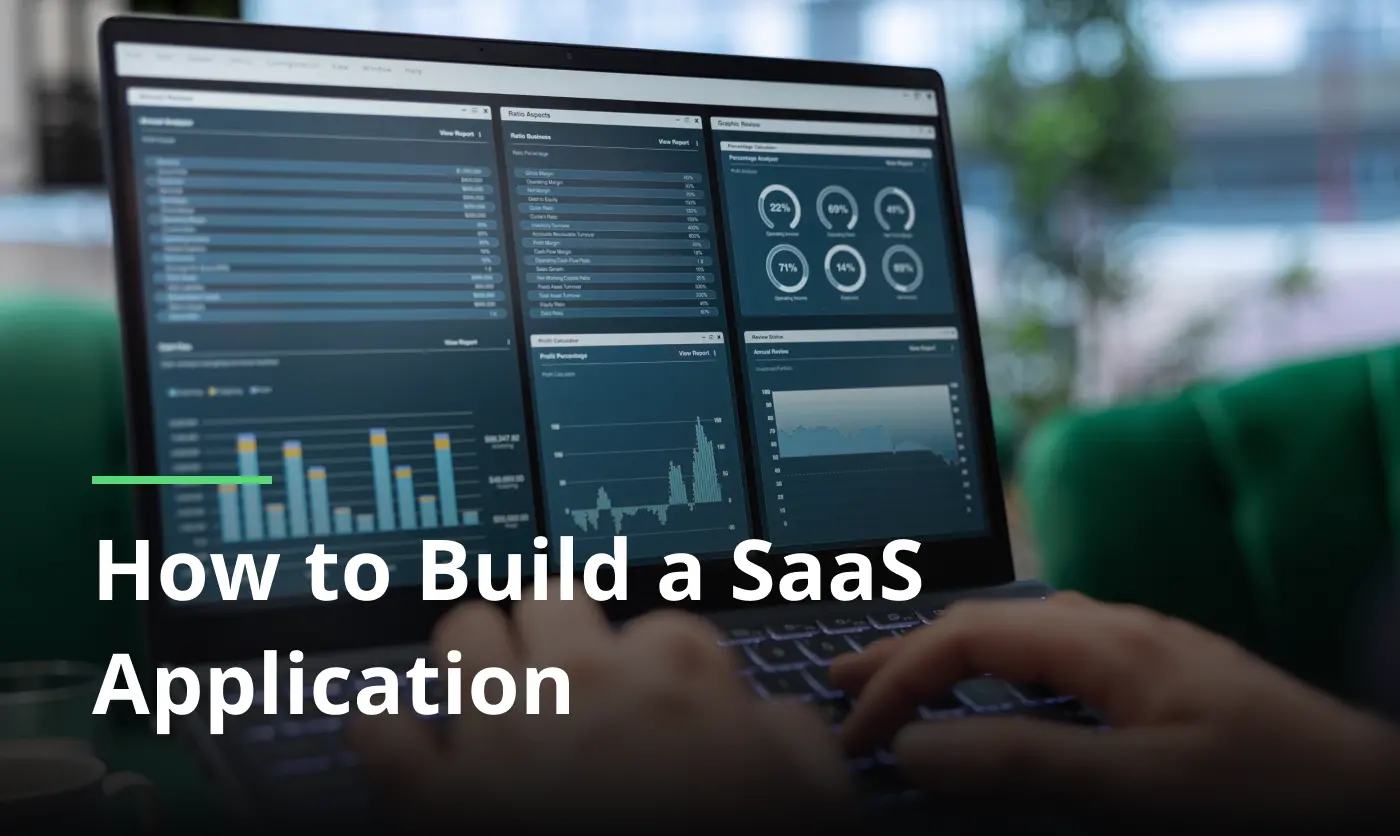
SaaS application development may look complex at first, but with a clear how-to guide, it becomes a structured and predictable process. Software as a Service can bring cost-effectiveness, better accessibility, and revenue opportunities. You just need to know all the nitty-gritty behind the building process.
In this manual, you will be guided through the SaaS app development with a proven step-by-step operation prepared by our experts. This roadmap not only provides you with key stages of creation but also technologies used, hourly rates for developers, features, difficulties, and more.
Whether you are a startup planning to develop a SaaS application or an enterprise optimizing internal workflows, this guide will help you navigate every step — from SaaS product idea validation to deployment.
What is a SaaS application?
A SaaS (Software as a Service) app is a solution that is accessible through the web, with no downloads or installations. This software is run in the cloud, requiring only a stable Internet connection.
If you have used Netflix, Slack or Shopify, that’s an example of a SaaS platform that can be used for managing projects, running eCommerce stores, and more. Instead of purchasing software, you are able to pay a subscription fee on an annual or monthly basis, and use the product.
In short, SaaS web application development is aimed at building scalable, fully customized, subscription-based solutions for businesses that have an idea of a product that customers would pay for monthly, the need for management for their operations, etc.
Types of SaaS mobile apps
There are many effective tools that can be built in terms of SaaS cloud application development and we will consider a few of the most in-demand that you can build using available tools or with a SaaS app development company.
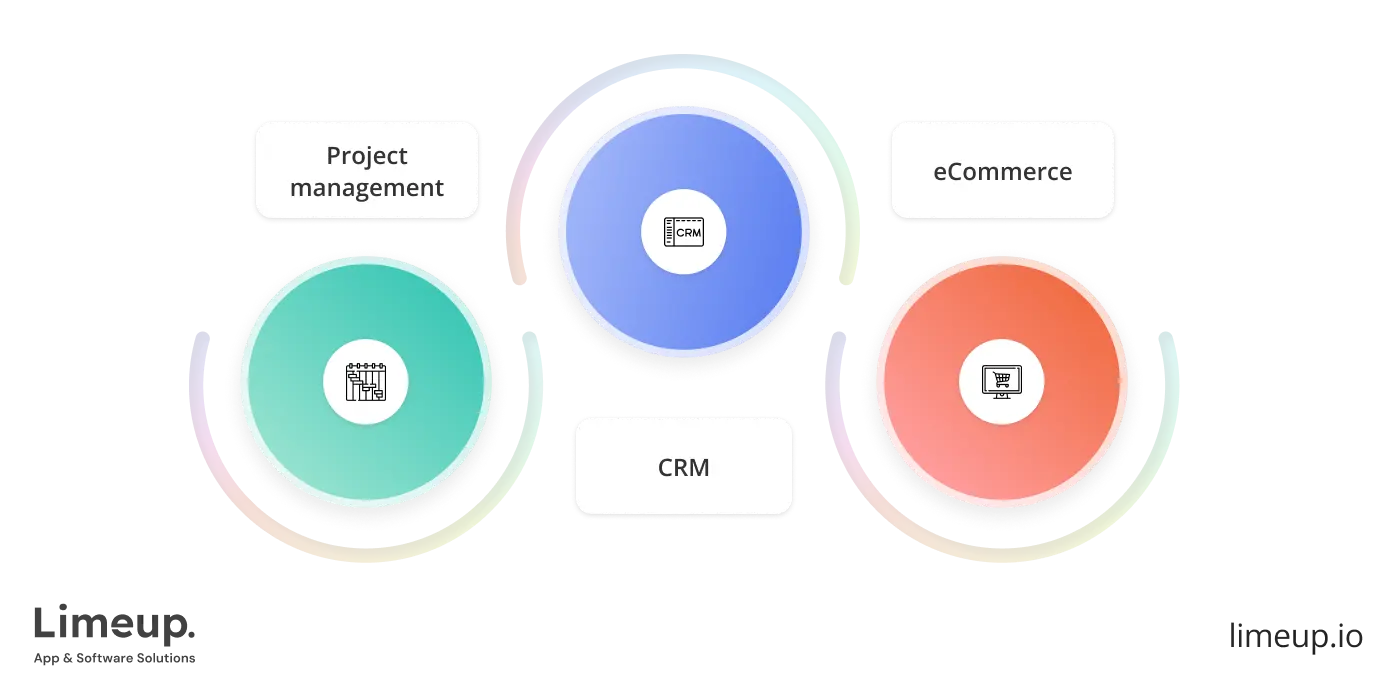
-
CRM (Customer Relationship Management) gathers together all the data that can be scattered within emails, comments sections and private messages in social media like Instagram or Facebook, website forms, or else. Also, it can be used for marketing, sales, advanced analytics, and so on.
Your departments will be able to automate manual tasks to save time and resources, improve monetization pipelines and money incomes, improve interactions with leads who will not be left “on read’ or in line for a long period of time.
-
Project management apps may sound similar to every person working with many tasks, for example, Jira or Trello, which are two of the most popular ones across SaaS. Such programs offer the highest workflow customization, strong visualization for analytics and an insightful decision-making process, etc.
- eCommerce resolutions like BigCommerce are common and rich in features, managed in the cloud, with specifics that meet unique business needs. There are tools from Adobe, Microsoft, and other vendors that cover different pain points, for example, reflecting on branding, providing built-in tools.
SaaS is also used in marketing automation (Mailchimp, HubSpot), finance (QuickBooks, Xero), and HR tools (BambooHR, Gusto).
The core point of a custom offering stands for the ability for you to receivethe one that 100% matches your demands, and further, you will learn how to make one with understandable stages and detailed descriptions.
Why build a SaaS application?
Businesses seeking flexibility and scalability choose SaaS products that also allow them to meet ever-evolving end-users’ demands and market trends, improve management, and more. Below, you will find the core advantages that a SaaS app can bring depending on your goal.
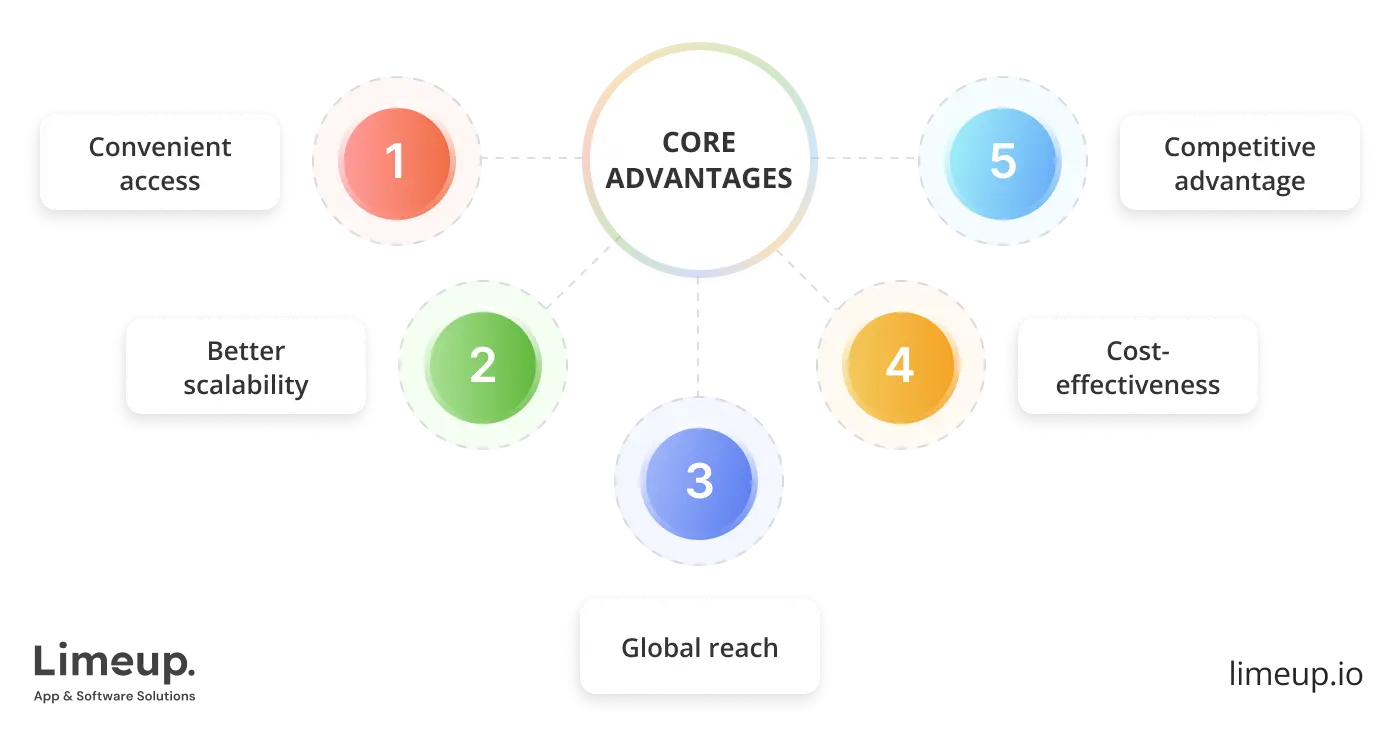
-
Convenient access. For CRM, analytics and administration solutions, it is essential to be able to enter the system from anywhere, using a mobile device or a laptop/tablet with Internet available.
All the data is stored in the cloud, from information about sales to customer personal information, so the workflow becomes more efficient.
-
Better scalability. The infrastructure used for application development for SaaS enables continuous updates of features according to the growth of users’ demands or even the amount of data you need to store and process.
-
Global reach. This benefit covers the requirements of retailers who would like to make inventory management easier, startups with a large target audience worldwide (clientele), and many others. SaaS apps help you to stay connected with clients, partners, employees, other organizations, etc.
Another crucial point stands for the access to experts across various regions, like UK app development companies, which are known for strong solutions for worldwide markets.
- Cost-effectiveness. Paying a monthly fee is less costly than having local infrastructure, as here, the provider takes the maintenance needs. Such a budget-friendly option is perfect for new players in crowded industries and for enterprises looking for new opportunities.
- Competitive advantage. First of all, you receive faster time-to-market delivery, and secondly, you gain deep insights into your operations, customer behavior, sales, and more.
As we defined the core reasons to build a SaaS app, it is time to move to the actual development process, as described by our specialists.
Key steps in SaaS application development
Clicking on this article, you definitely wanted to add fuel to the fire of success with a SaaS app, and we will help you cast your net wide with 7 competent stages proven by our 10+ years of experience.
These phases are also the ones to expect when you decide to hire a mobile app developer who can deliver a SaaS platform. We will walk you through the initial stage to going live and beyond.
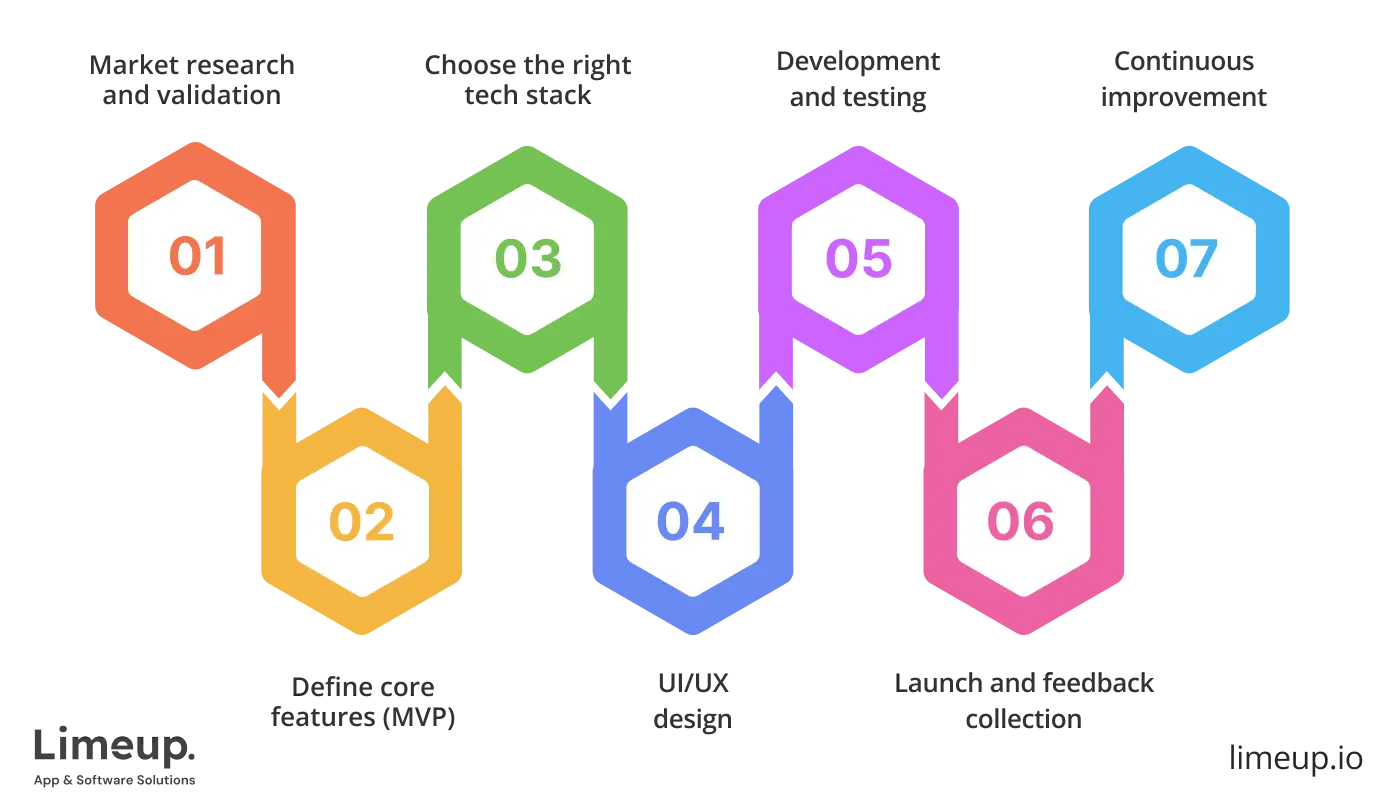
Step 1: Market research and validation
As you need to know who you are building this solution for, moreover, as markets are highly competitive and the SaaS app has to be reliable to end-users’ needs, this stage is fundamental. It includes:
- competitors research
- user persona building
- pain points to solve
- surveys from target audience
These points will help you in identifying unique values you can propose to your users, and validate if your idea for a SaaS-based app development will be profitable.
Step 2: Define core features (MVP)
Minimum Viable Product is a proper strategy that secures businesses from failure. According to the statistics, 90% of startups fail, and the reasons are wide, like not fitting the market needs. An MVP with basic functions allows you to see the big picture of your idea and ensure it will be a winning project for you.
Here are some crucial features for your fundamental product:
- Enhanced privacy
- Subscriptions integrated
- Advanced analytics
- Management for subscription
Step 3: Choose the right tech stack
To build a SaaS app that will be efficient and robust, you need to select proper technologies that will fulfill your needs. Here is a brief breakdown of every technology commonly used by experts from our mobile app development company in the UK:
- React
- Laravel
- Node.js
- Python, and others you can read about in this part of the article.
Step 4: UI/UX design
User experience and user interface design define if your SaaS application will satisfy end-users’ expectations in intuitiveness, accessibility, if they will find it pleasurable to use and worth returning to and pay monthly for your solution.
The core principle of designing UI and UX is to make everything simple yet reliable, in other words, citing Frank Chimeri, a designer, “People ignore design that ignores people.” So you have to ensure that your product has easy onboarding, intuitive navigation, personalized elements, and other crucial points.
Step 5: Development and testing
This stage stands for the actual creation of your app with the usage of SaaS application development best practices for back-end, front-end and security aspects. First, you need to set up the cloud infrastructure, like AWS or Google Cloud, design databases, and integrate third-party services like analytics, CRM, payments, or else.
Secondly, you move to the front-end which means it is time to create responsive elements you users will interact with directly. It also requires you to ensure compatibility with different browsers and devices.
Thirdly, you have to take care about the security, considering RBAC model (role-based access control) to manage what can be modified and by whom in your departments, compliances like GDPR for data protection or another according to your industry.
Lastly, QA is a must-have if you want to ensure that the solution works bug-free and performs well with no vulnerabilities. It is advisable to conduct manual and automated tests for usability, integrations, data protection.
Step 6: Launch and feedback collection
After finishing the pre-launch set of activities, you are ready to go live and present your application to end-users, gather their feedback and define aspects that need to be fine-tuned. You can use special forms inside of your SaaS app, analytics tools, and review tickets from people with descriptions of their experience.
Based on our background, it is preferable to set KPIs to measure your current success: how many visitors and users are active, the number of subscribers, their engagement, and more.
Step 7: Continuous improvement
We have come to the final point of your journey called, “How to develop a SaaS application?” Here, it is not over as your product is meant to be maintained and improved, so you need to keep analyzing reviews from clients, plan security and functions updates, and react immediately to bugs or downtimes.
For now, you are armed with the knowledge of the whole process, and we are ready to move to discovering what functions you need for a robust system that will work toward your business objectives.
What are the key features of custom SaaS app development?
When you decide to create a fix to this complexity, it’s essential to receive full-fledged support with materials like this so that you are able to develop an app that will be built on borrowed thunder.
To set the path of success, you need to learn about the core functions that have to be added to your project. Let’s skip the talking staff and dive deeper into actual options to incorporate for effectiveness and robustness:
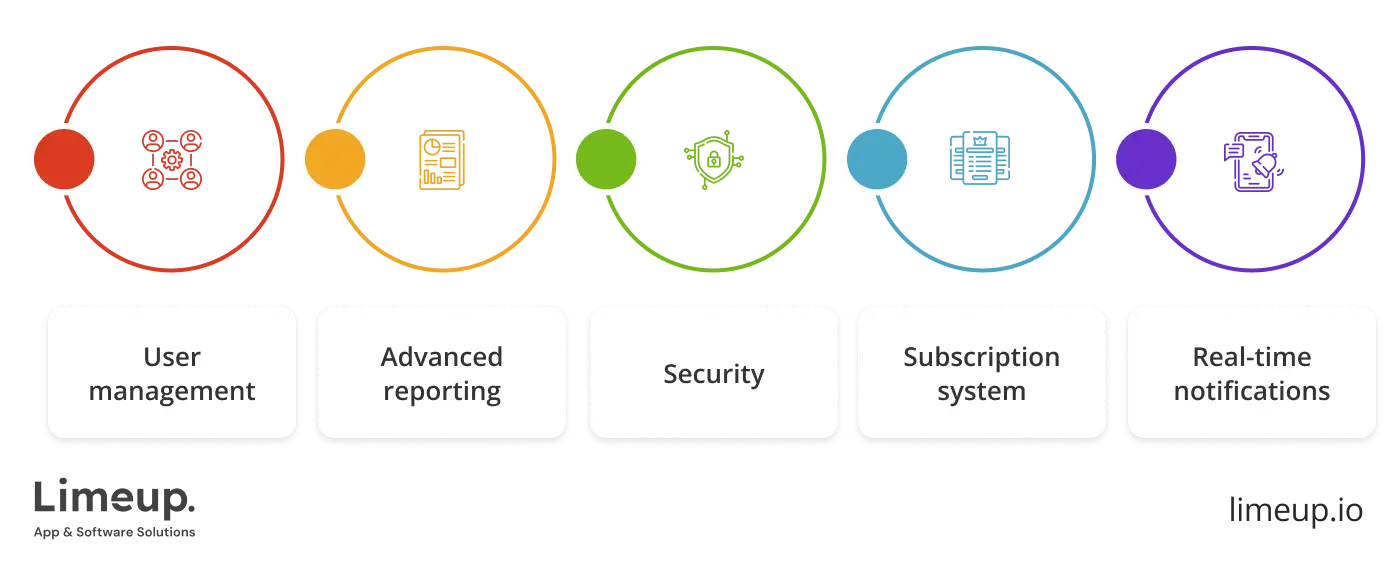
- User management is more than just about sign-up and login processes that include interaction with email and social media, but also about MFA (multi-factor authentication), which adds an extra protection layer. For example, Microsoft provides methods on Entra ID.
-
Advanced reporting is a proper function for businesses that would like to remain competitive in the long term as you can create more than just a dashboard with core metrics but a customizable one.
When it comes to off-the-shelf products, making reports there feels like herding cats, as your employees can not simply build one according to the data they need, while a custom solution allows them to use strong filters, choose visualization, and set more parameters.
-
Security is the standpoint we will mention again and again as you may know that the number of cyberattacks increases, and you have to protect your system and built-in tools, sensitive information. SaaS applications development with safety in mind will ensure you are capable of demonstrating a commitment to privacy.
-
Subscription system is a complex function that includes subcomponents: free trials for new users, payment interactions for more efficiency, like Stripe or PayPal, the ability to update the premium plan, track payments, and more.
If your goal is monetization through SaaS, this feature must be there as a source of income, supported by management and automation. For example, automated billing can be a game-changer when your customers do not need to renew their subscriptions manually; you just send a notification: “You will be charged in two days.”
-
Real-time notifications are defined as a crucial feature by our customers, who asked us to implement it so their departments can remain on the same page with other teams and solve issues immediately. Why is this vital? — because it’s proven that delays may lead to pure impact and have a negative impact on productivity.
Building a SaaS application with alerts in functionality, you will also receive beneficial moments as answering urgent challenges, prioritizing tasks for time management, and increasing responsiveness.
As for our experience, the final decision on functions depends on the type of system you would like to receive, and we named the basic (yet vital) aspects that work towards flexibility and scalability.
As we considered in the previous part of this article — “What is SaaS application development?” and the functions — you will spend some time defining your goals, and during this phase, you will write down what needs to be done. Using our list, you will simplify the process of outlining premier features to get the most out of your project.
Technologies used in SaaS based application development
Though developers make jokes that it is the tech stack that chooses you, it is essential to choose the right tech stack since it defines your app’s performance, ability to handle traffic and data loads, build loyalty, and receive revenue.
Below, you will find the breakdown of all common technologies used by coders who are proficient in SaaS application development services.
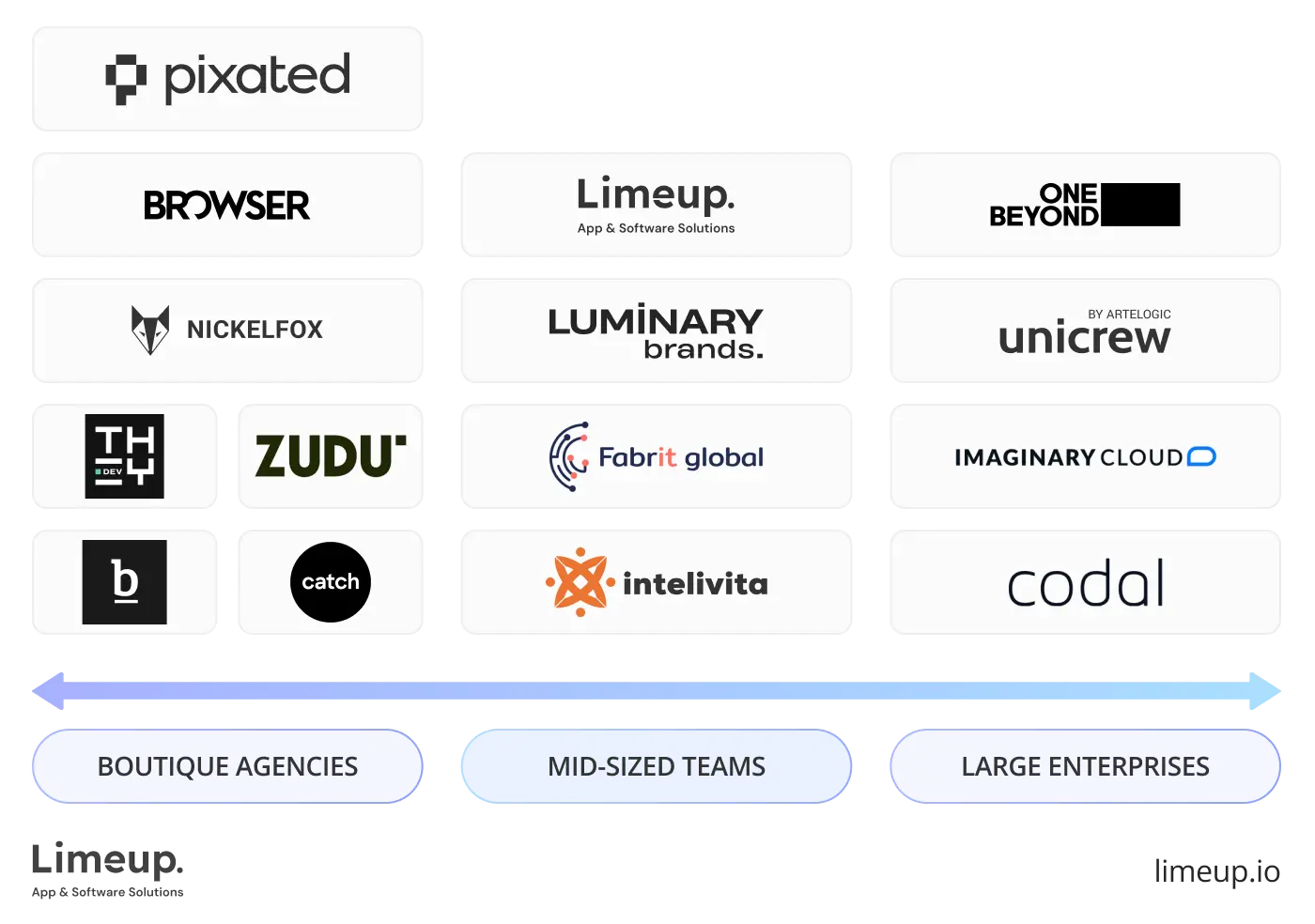
Back-end technologies
They make your solution perform according to the plan, being a skeleton for any app you have used in your life. Let’s check on them:
- Python (or Django), Node.js (NestJS), JavaScript — server-side logic for real-time applications.
- Ruby for MVPs and rapid prototyping.
- REST APIs, GraphQL, WebSockets for APIs.
💡 Tip: If you need an AI-powered app, you can use Python. As well as for startups, it is preferable to select Python and Node.js.
Front-end frameworks
Front-end defines what end-users see when they use your SaaS application, so you have to ensure it downloads faster, it is reliable, smooth in interactions, and all elements are displayed nicely. Here are the technologies that help you with this task:
- React.js for reusable UI components, for cross-platform purposes.
- Vue.js — responsive UX, modularity, smooth integration.
- Angular makes the management of large apps easier.
💡 Tip: There are battle-tested technologies like React.js that are known for flexibility and can be used effectively.
Cloud platforms and databases
These platforms are basically infrastructure for your application, used in SaaS applications development to host, maintain, scale up or down. Here are the core of them:
- AWS from Amazon can be used by all types of businesses, from newcomers to enterprise-grade firms.
- Google Cloud is known for its suitability for on-premise systems that need to be migrated to the cloud.
- Azure by Microsoft is flexible and highly secure, a perfect option for companies that have already integrated Microsoft products into their operations.
- MySQL, MongoDB, PostgreSQL — database management.
💡 Tip: Select the combination of databases that has different purposes to receive the most out of it.
All the named technologies can be used for scalable and robust SaaS applications. Your choice has to be based on your requirements for features, UI/UX design, and complexity of integrations.
It is advisable to keep in mind that you need the tech stack that makes your solution rich in features, user-friendly, and intuitive for all types of users. As it stands, let’s move to the question of the price you need to pay to create your product.
How much does it cost to develop a SaaS application?
Placing all the cards on the table in the pricing question, we are ready to announce that in most cases, there are no pre-made blueprints that you can open and say, “OK, that’s how much I need to pay,” but our experts prepared a clear approximate estimation.
We have defined how to build a SaaS app with core functions and terms, so leaving you without the answer to the pricing quiz is not our style so here is a comparison table that will help you to review the average cost according to the solution’s complexity.
| Type | Average $ |
| MVP | $15,000–$39,999 |
| Mid-sized | $40,000–$99,999 |
| Advanced | $100,000–$249,999 |
| Enterprise-grade | $250,000+ |
Factors affecting cost
You have gathered information about the creation process and technologies required to build a SaaS application, which are the two aspects influencing the final price the most. Still, there are others that require your attention and need to be considered when budgeting for SaaS mobile app development.
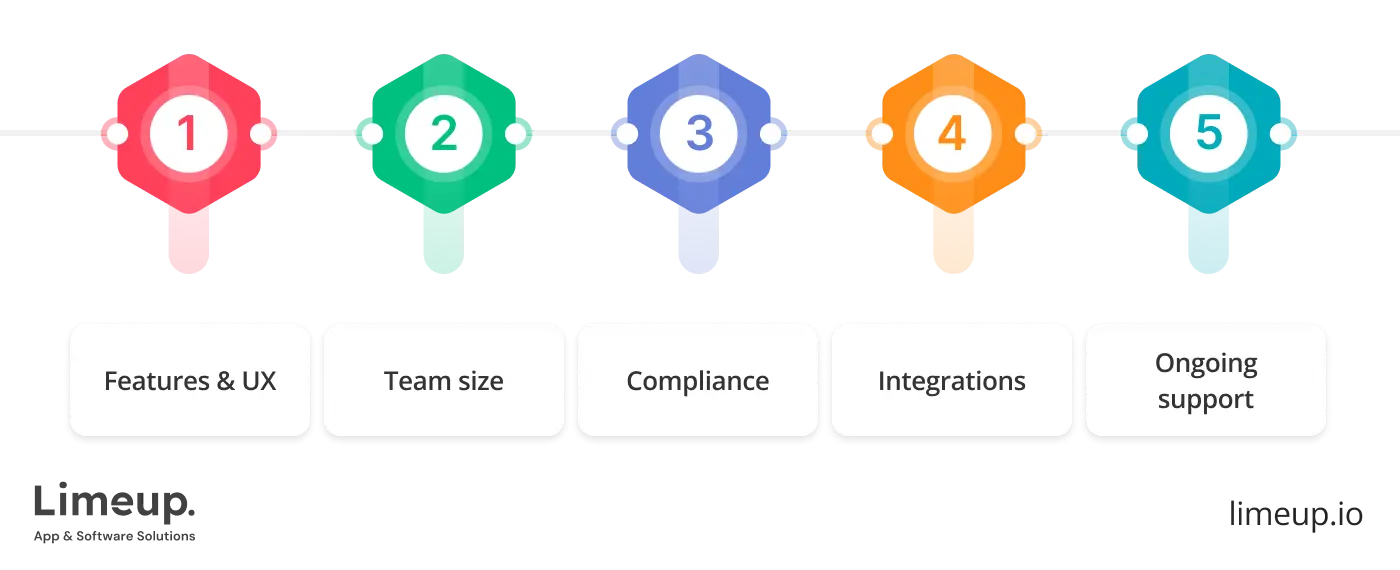
- Features. While simple solutions with basic functionality can be built for less money, fully customized apps with advanced technologies usage — like AI for analytics — and a real-time cooperation feature will cost more.
- User experience. A great UX design works for your reputation, whether you are a newbie or a well-known business launching new products. Custom and responsive design powered by branding from a seasoned SaaS application development company ensures your long-term relationship with clients.
- Team size. This aspect is connected with the previous two because the number of experts you can engage impacts not only your flexibility but budget. Senior and middle coders will charge more than juniors, but they can handle challenging projects, while entry-level experts are perfect for small products.
- Compliance. Industries like healthcare and fintech are widely regulated, with ISO 27001 standard, HIPAA and some local regulations according to your operation regions. Here, you may need to add some extra protections for data stored, conduct third-party audits.
- Integrations. Some complex APIs require specific knowledge and technologies, for example, if you need to integrate a payment system, chatbots, CRM, or some licensed systems.
- Ongoing support. This service costs around 15–20% of the initial SaaS web app development budget, and you need to calculate it as a constant fee because it is required as long as your SaaS app works.
Being aware of these influencing factors makes you armed for a cost-effective solution-building. You are able to make a budgeting strategy that is friendly for your business and meets your capabilities without breaking the bank.
For example, if you are looking for more cost-effective cooperation, it is worth considering cross-platform mobile app development companies that build apps for iOS and Android simultaneously.
For now, let’s discover the average rates from programmers worldwide to empower your decision-making process.
Hourly rate of SaaS app developers
According to the information our specialists gathered from different sources, the cost depends on factors like the coder’s location, experience, case study records, technology stack, and more.
When it comes to SaaS application developers, you can expect hourly prices between $25 and $300 according to Clutch, while Upwork portal has rates from $19 to $340+ according to what the coder can offer. Here is the comparison according to their level of experience:
| Level (years) | ~$ |
| Junior (<2) | $20–$40 |
| Middle (3–5) | $40–$70 |
| Senior (5–7) | $80–$150 |
| Veteran (7+) | $150–$300+ |
Sometimes, you can receive a full-packed service, for example, a basic app creation, for $30,000. As it’s said on some forums for business owners, they have experienced cooperation with engineers who charge around $60 hourly.
Challenges to consider when building a SaaS app
For business owners, SaaS can be as clear as mud as they don’t work with it daily, so implementation can be a daunting task, with a set of hurdles that can be overcome with a proper approach.
Therefore, your goal is to avoid any headaches when creating a SaaS application, and our experts have prepared a list of challenges you can meet and tips to beat them. Let’s dive into details:
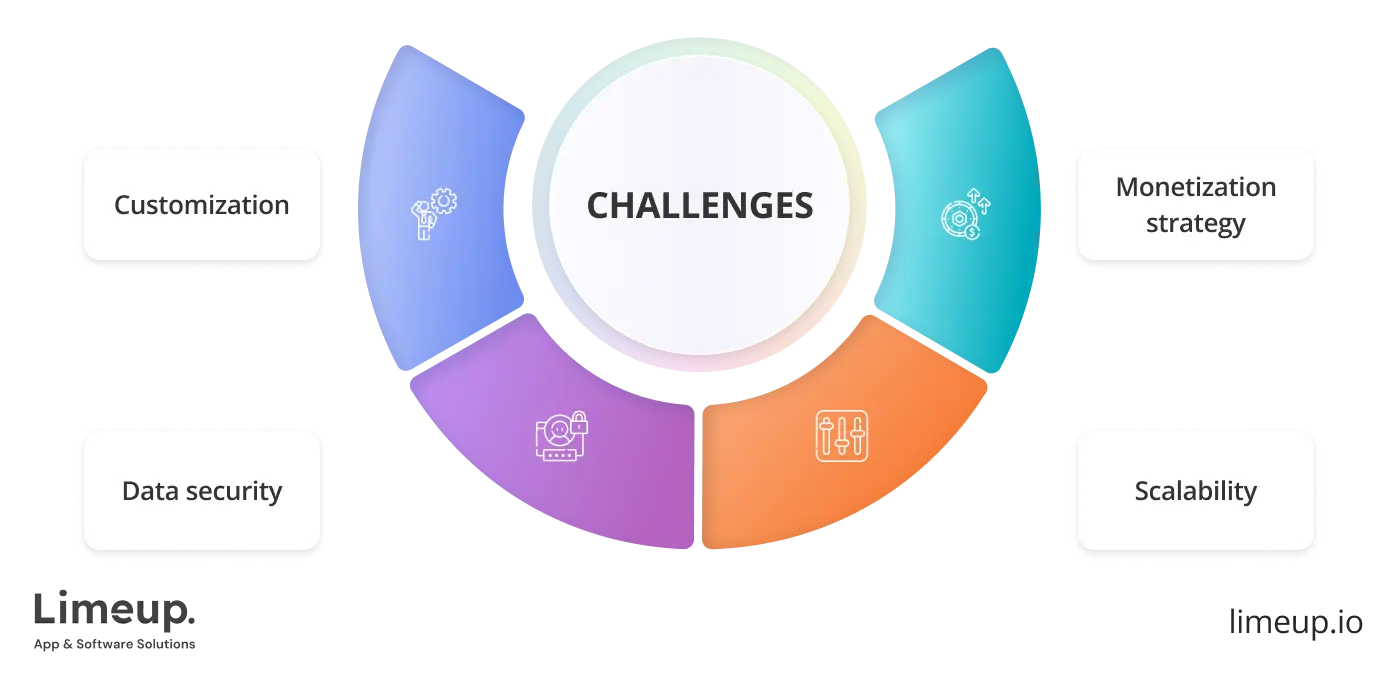
Data security
As it can become a game-changer, our specialists decided to include security in challenges, too. How can it be so challenging? — mostly, because phishing attacks are growing, as well as attempts at data breaches, and the scattershot of access across users.
You have to protect the information from leaks and breaches, as well as adjust it to compliance like GDPR. For instance, if you ignore the need of 2FA, someone can steal the password and access your confidential data.
💡Tip: Invest your time into security practices during each phase of development, as well as ask your coders to check every code line, encrypt data, use strong audits and penetration tests, stay updated with compliance according to your niche and jurisdiction.
Scalability
The advantage and challenge, this point has to be considered carefully in terms of architectural design and maintenance. The hard moment relies on handling large amounts of data without bottlenecks.
Let’s say that your app has been downloaded by 100 users, and the system works fine. After a successful promotion cooperation, you receive 10,000 new clients who subscribed to your service. If your app lacks scalability, new end-users will experience slower page downloads, failed syncs, and more.
When you overcome this challenge, you are able to balance the SaaS product with the number of active users and not lose them due to poor performance.
💡 Tip: Consider adopting microservices where you can change every part without affecting the whole system and platforms that support auto-scaling.
Monetization strategy
When stepping into SaaS app development, you need to decide the way you want to charge your customers, your retention policy, special discounts, a free trial, and maybe even a referral system. The core point here is to balance the cost of subscription that will increase your profit but will not deter new customers.
You also need to take into account that your strategy will change with time, as you scale up the SaaS application. More features — higher cost, and, as a result, optimization of your subscription plans.
💡 Tip: Make a well-versed target audience analysis to determine what pain points they would like to cover, if possible, you can even test various prices and see what works best.
Customization
Since you need to fulfill the needs of various users, it becomes a challenge to make every UI layout and function tailored to them. Moreover, you need to keep the whole system stable and customized for various purposes.
Let’s say that your SaaS app is aimed at helping with management for retailers. Small businesses may need the basic features while enterprises require AI-driven analytics which is an advanced function. That’s the crucial challenge — to fulfill requirements from completely separate companies.
💡 Tip: To win this challenge, you can focus on configurations rather than on fully customizable features, remaining flexible for evolving customers’ needs.
We outlined some strategies you can implement to make the SaaS creation more affordable and easier, so that nothing will limit you during the whole process.
Undoubtedly, you can encounter more difficult situations according to the app of your dreams, such as complex integrations or user experience. You can also contact a provider of SaaS app development services for a consultancy.
Ready to create your SaaS application?
As a company that has been delivering SaaS solutions for the past 10 years, we know that it can feel like you are climbing a greasy pole; that’s why we created this material. For now, you are aware of all the nuances about such a development process, from challenges to cost.
Streamlined and intuitive products bring into play many beneficial moments, from reduced time for manual tasks to higher revenue through new monetization channels. That’s why this technology is more than just a trendy one, being a must-have for businesses that want to remain competitive.
If you would like to cooperate with a SaaS mobile app development company that has a proven track record of SaaS apps in fintech, real estate, education, hiring, and other industries, consider contacting Limeup. We will schedule a free call to discuss your needs and ways to kick off the project right away.
FAQ (process & practice)
How long does it take to develop a SaaS application?
You can expect to spend from 2 months to 1+ year depending on the complexity of your functions, the level of customization, etc. You need time to get a SaaS application developer or a team and with an MVP, ensure that your customers will pay for the product you would like to create.
What are the main benefits of SaaS applications?
- Better scalability
- Easy entering
- Lower infrastructure costs
- Advanced security
- Enhanced productivity
- New revenue opportunities.
How do I choose the right tech stack for my SaaS app?
It starts with defining your requirements for a SaaS solution: core features, third-party integrations, scalability plans, and compliance regulations according to your industry and location.
For more convenience, you can also check if the technologies of your choice have large community support so that you can ask for help and advice, and if it is proven by related projects.
How do I ensure data security in SaaS applications?
This point is aimed at sensitive information protection and making sure that only registered users have access to the cloud. Here are some practices that will help you to keep your SaaS app secure:
- Multi-factor authentication like a special PIN, password, biometric, etc.
- Data encryption allows you to secure the way data is transmitted between end-users and servers.
- Real-time monitoring covers logins and activity tracking to detect unusual behavior and alert when it happens.
How to select the provider for SaaS application development solutions?
Here is a simple and effective checklist for you to choose the best vendor for your SaaS project.
Following it, you will be able to cooperate with SaaS application development consultants who fit your needs.

